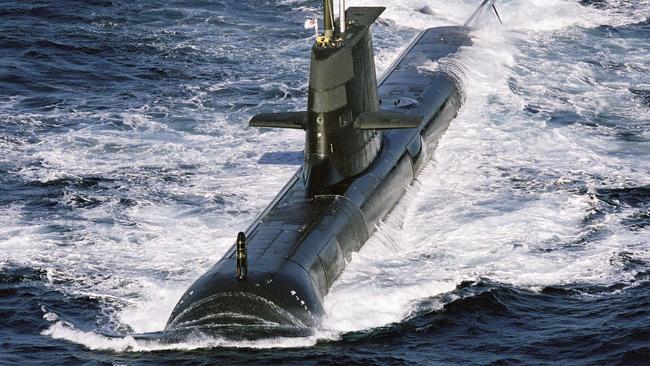Navy in deep water over lack of crew to operate $50bn subs
The navy faces a future challenge to find and train crew for its next-generation submarines.

A review of navy planning warns fundamental changes will be needed to ensure sufficient crews for the nation’s $50 billion next-generation submarines, including better pay, family-friendly conditions and recognition of submariners as an elite force.
The independent report, obtained under Freedom of Information laws, warned that doubling the submarine force from six Collins-class to 12 Attack-class boats posed significant challenges requiring “far-reaching” changes to training and posting of submariners. The paper comes as the navy struggles to find sufficient personnel to crew the vessels it already has, with the Anzac-class frigate HMAS Perth in dry dock since 2017 because of a shortage of qualified sailors.
The authors, retired vice-admiral David Shackleton and Reserve Rear Admiral Boyd Robinson, said allowing submariners to better balance their personal and professional lives was essential to finding and retaining talented Australians with multiple career options.
“Members of the submarine arm and, critically from a retention perspective, their families, will not unquestioningly accept they must unconditionally sacrifice their own aspirations for the duration of their navy service — even in an all-volunteer force,” the review said.
A submarine engineering officer in his or her third year of service currently earns about $114,000, including an $18,309 submariners allowance and a $13,991 service allowance.
The paper said new “targeted financial retention measures” could be required to ensure a “high rate of growth” in the submarine workforce.
However, it warned pay rises were not the long-term primary solution: “A simple and effective non-financial measure has been enforcing rules associated with respite from sea service.”
The report said one weakness of the submariner training system was the deferral of “actual submarine suitability testing” until “later in the training continuum”.
“Considerable investment may therefore be lost if a sailor fails the rigorous submarine suitability testing and training because there is not always opportunity for these sailors to complete their specialist training and qualification in the surface fleet,” the report said.
Improved career paths were needed, along with recognition of submariners as belonging to a special class of naval officers.
Efforts to boost the Collins-class submarine workforce had been broadly successful, but future workforce shortages would not be addressed through traditional transfers elsewhere in the navy, the review said.
“We believe one of the fundamental changes required is for officers of the submarine arm to be inducted, trained and retained as a full naval career,” it said.
“The demands on these officers are such they must be regarded differently from members of the wider navy for their unique skills and experience.”
The report said that as of July 1, 2018, the nation’s submarine workforce stood at 780 — sufficient to maintain five Collins-class crews. It said this was a “remarkable achievement” considering five years earlier it had just 497 submarine personnel.
Centre Alliance senator Rex Patrick said the navy had done well to address the shortage of submariners but delivering the extra workforce required to crew the future submarines would be a huge undertaking.
“It’s hard to get blood out of a stone once, much less twice. This is Australia’s largest defence acquisition program. It is loaded with performance, schedule and price risks,” he said.
“If we are fortunate enough to pull this off, the last thing we need are submarines tied up at the wharf because there aren’t enough trained crew.”
Defence Minister Linda Reynolds said Defence was undertaking long-term workforce analysis and planning to support the navy’s future submarine and surface forces. “Navy has already made good progress toward an increased workforce with initial entry training courses at near maximum capacity. Navy’s recruitment targets have increased by 40 per cent since early 2018,” she said.
Defence’s incoming government brief, obtained by Senator Patrick, also revealed personnel recruitment and retention remained key challenges.
The brief said despite a “relatively calm and stable maritime environment”, the navy’s “funded strength had reduced by 30 per cent over the two decades from 1982 to 2002”.
The ability to service a ship or submarine at sea was described in the brief as being “fundamentally different to most professions”.
“It requires technically competent, highly trained, fit and motivated people who are ready to go to sea and operate remotely — often without connectivity with loved ones for extended periods.”
The Australian Strategic Policy Institute has also raised an alarm over Australian Defence Force numbers, finding it had failed to achieve “modest” personnel recruitment goals laid out in the most recent defence white paper, published in 2016. “Overall, it’s only increased by 600 actual people against a target of around 1730 over the period since the white paper,” it said in a June 5 briefing.




To join the conversation, please log in. Don't have an account? Register
Join the conversation, you are commenting as Logout